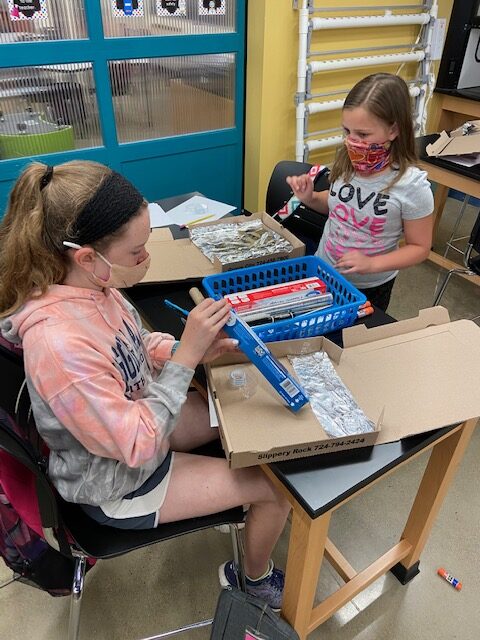Science, technology, engineering, art, and math. These five disciplines have become integral to 21st-century skills and careers. But how can we ensure that STEAM programming benefits students who have the least access to relevant, high-quality learning opportunities—like rural learners, girls, and students of color?
And how can we recognize the shared challenge of all marginalized students, while also accommodating the unique and even overlapping experiences of each?
We recently chatted with a school administrator and out-of-school-time provider on how they’re enhancing STEAM education in their respective spaces and creating more rigorous, inclusive, and affirming STEAM learning for students.


Students take part in Grove City Area’s Engineering is Elementary program.
Joshua Weaver, Assistant Superintendent of Grove City Area School District
Q: Why is STEAM education so important, specifically for learners in rural areas?
A: In more urban or affluent areas, opportunities in STEAM are generally more readily accessible. When you’re in more of a rural setting, you have to work to create those opportunities for students. A big passion of mine has always been to help students become more thoughtful and solve real-world problems. At Grove City Area, we focus on resiliency to teach students how to work through failure without feeling defeated. Creating that in any environment is important, but especially with our rural learners.
Q: How does Grove City Area School District’s STEAM curriculum serve all students, especially female learners who often feel marginalized in many of these areas of study?
A: For K-5, we’ve adopted Engineering is Elementary. I’ve seen students of all backgrounds thrive with the hands-on nature of the program, learning to work both independently and collaboratively. Once in middle school, our students participate in Inventionland. When we first became involved three years ago, our team of female students won the regional middle school competition. That opportunity really opened the doors for those girls, showing them that they could become entrepreneurs. Our teams have won the competition every year since. Lastly, our high school has partnered with Grove City College to bring engineering opportunities to our tech-ed classes. We’re actively working to combat the stereotype that engineering and technical design are male-dominated industries.
Q: How can other schools and programs integrate more holistic experiences in STEAM?
A: Networking is key. There are a lot of schools in western Pennsylvania doing some really amazing things. There isn’t one textbook or course that will check every box for your students, so I advise fellow educators to pick up the phone and find out what other institutions are doing, what works for their students, and what doesn’t. We at Grove City Area invite members of the Remake Learning network to collaborate and tour our facilities. There’s so much to learn from each other.


Students learn African drumming at Aliquippa Impact.
Christyn Gilliam, After School Program Coordinator at Aliquippa Impact
Q: What types of STEAM experiences does Aliquippa Impact offer for students?
A: Our students are exposed to a variety of STEAM opportunities. Through summer camp, students build Legos to show what kind of world they want to live in and engage in art therapy with a local artist. Our after-school program has also drummed along to African beats with a local musician. The kids have fun while learning to express themselves and better represent their lived experiences through art, music, and design. Around 98% of our students are Black, so it’s important for us to show them what they can create to give them a sense of self-identity and self-worth.
Q: What skills are students gaining through these experiences?
A: We have a strong focus on student development, utilizing the Search Institute’s 40 Developmental Assets as a framework for our curriculum and strategies. Our founder Joel Repic often says, “If you place the crown over the child’s head, they’ll grow into it,” and that really guides a lot of what we do. We nurture student abilities that aren’t always catered to. Showing up in a kid’s life leaves a lasting impact. Many of our kids have been disappointed in the past because people stop showing up for them. Ultimately, we teach them to create and express without fear of judgment.
Q: How can out-of-school providers supplement what students are learning in the classroom with STEAM?
A: At Aliquippa Impact, we keep the momentum going from what our kids learn in school. Our programs are purposeful and intentional, yet we are lucky to not have to stick to certain curriculums and often move with the kids in terms of programming. For example, if the students come into the classroom bursting with energy, we’re going to adjust our activity that day to match their excitement. We had a tough fifth and sixth-grade class that loved working with their hands, so we created an activity where students build bridges with spaghetti noodles. We allow them to lead their own experiences, helping to see them through. I think that is my best advice for other OST leaders—to let students play a part in their own learning. We’re also always looking for volunteers or STEAM educators to come on board with us, especially as we look to this upcoming school year!
As Remake Learning wraps up our July celebration of STEAM and Computer Science, we’re honored to highlight these local educators who are working to ensure every student has the opportunity to learn and grow within the STEAM disciplines.
If you’d like to join our commitment to STEAM and CS, learn more about our working groups, Connect with Josh at joshua.weaver@gcasdk12.org or Christyn at cgilliam@aliquippaimpact.org.
